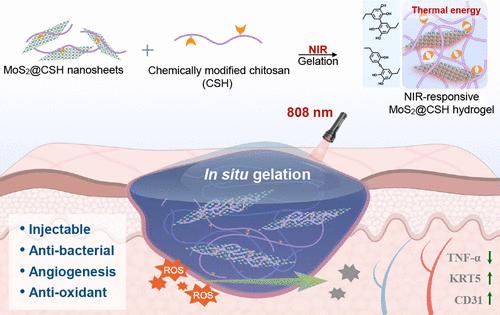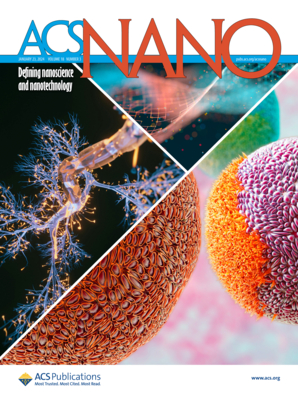Engineering Injectable Coassembled Hydrogel by Photothermal Driven Chitosan-Stabilized MoS2 Nanosheets for Infected Wound Healing
IF 15.8
1区 材料科学
Q1 CHEMISTRY, MULTIDISCIPLINARY
引用次数: 0
Abstract
The application of enzyme-like molybdenum disulfide (MoS2) in tissue repair was confronted with stable dispersion, solubilization, and biotoxicity. Here, the injectable self-healing hydrogel was successfully designed using a step-by-step coassembly of chitosan and MoS2. Polyphenolic chitosan as a “structural stabilizer” of MoS2 nanosheets reconstructed well-dispersed MoS2@CSH nanosheets, which improved the biocompatibility of traditional MoS2, and strengthened its photothermal conversion and enzyme-like activities, guaranteeing highly efficient radical scavenging and antimicrobial properties. Furthermore, the polyphenol chitosan was employed again as a “molecular cross-linking agent” to form the injectable NIR-responsive MoS2@CSH hydrogel by accelerating hydrogen-bond interaction among chitosan and the multicross-linking reaction among polyphenols. The rapid self-healing ability was conducive to wound closure and dynamic adaptability. An experimental study on infected wound healing demonstrated that MoS2@CSH hydrogel could substantially eradicate bacteria and accelerate the angiogenesis of infected wounds. The photothermal-driven coassembly of MoS2 and polycation provided an alternative strategy for infected wound healing.

利用光热驱动壳聚糖稳定的 MoS2 纳米片工程化可注射共组装水凝胶,促进感染伤口愈合
二硫化钼(MoS2)在组织修复中的应用面临着稳定分散、溶解和生物毒性等问题。在这里,利用壳聚糖和二硫化钼的逐步共组装,成功设计出了可注射的自愈合水凝胶。多酚壳聚糖作为MoS2纳米片的 "结构稳定剂",重构了分散良好的MoS2@CSH纳米片,改善了传统MoS2的生物相容性,增强了其光热转换和类酶活性,保证了其高效的自由基清除和抗菌性能。此外,通过加速壳聚糖之间的氢键作用和多酚之间的多重交联反应,多酚壳聚糖再次被用作 "分子交联剂",形成了可注射的近红外响应型 MoS2@CSH 水凝胶。其快速自愈能力有利于伤口闭合和动态适应。一项关于感染伤口愈合的实验研究表明,MoS2@CSH 水凝胶能显著消灭细菌,并加速感染伤口的血管生成。光热驱动的 MoS2 与多阳离子共组装为感染性伤口愈合提供了另一种策略。
本文章由计算机程序翻译,如有差异,请以英文原文为准。
求助全文
约1分钟内获得全文
求助全文
来源期刊

ACS Nano
工程技术-材料科学:综合
CiteScore
26.00
自引率
4.10%
发文量
1627
审稿时长
1.7 months
期刊介绍:
ACS Nano, published monthly, serves as an international forum for comprehensive articles on nanoscience and nanotechnology research at the intersections of chemistry, biology, materials science, physics, and engineering. The journal fosters communication among scientists in these communities, facilitating collaboration, new research opportunities, and advancements through discoveries. ACS Nano covers synthesis, assembly, characterization, theory, and simulation of nanostructures, nanobiotechnology, nanofabrication, methods and tools for nanoscience and nanotechnology, and self- and directed-assembly. Alongside original research articles, it offers thorough reviews, perspectives on cutting-edge research, and discussions envisioning the future of nanoscience and nanotechnology.
文献相关原料
| 公司名称 | 产品信息 | 采购帮参考价格 |
|---|
 求助内容:
求助内容: 应助结果提醒方式:
应助结果提醒方式:


